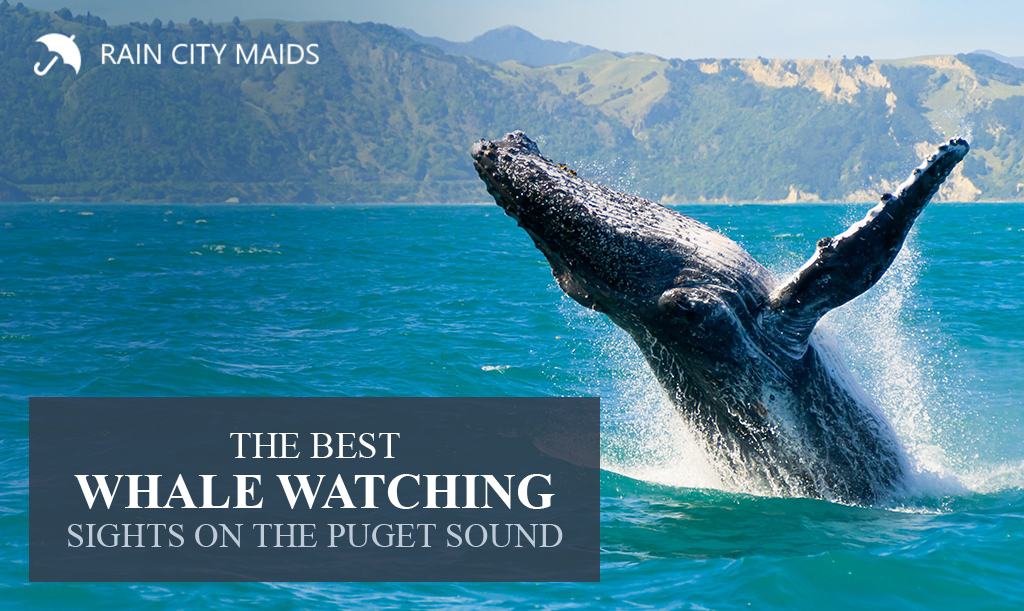A resounding huff is followed by a giant cloud of vapor rising over the water, and a gigantic gray body surfaces before crashing hard against the waves, accompanied by the ‘oohs’ and ‘aahs’ of the people on your boat. The arrival of migrating whales to the Puget Sound is an undeniable signal of spring to Seattle, and one of the best sights of the year for the area.
Watching the Sound’s oldest and largest residents is a joy, but while booking a trip is the preferred option for most, there are many ways to go about it depending on what species of whale you’re watching, the time of the year, and yes, even if you’re on a boat or not. We’ll go over some of the basics and offer you tips to make the most of your experience.
Know your whale-neighbors
Even though orcas are the most common and popular sight in the Sound, many of their cousins also make an appearance throughout the year. First of all, while orcas can be spotted year round, they’re also most common during the spring and summer, and the three pods that are known to frequent the Puget Sound are de J, K and L pod (a tour leader will be able to tell you which one you’re looking at).
The Minke and Humpback whales are also most common around spring and summer, and while not as numerous as their black-and-white counterparts, you can still see them often around spring and summer.
Gray whales are also very famous because they stop at the Puget to say hi on their long trip between Baja California down in Mexico to Alaskan waters, and are a common sight during the months of March and April.
Know your tours
The most common whale watching tours involve groups ranging from 20 to 100 people in boats of different sizes. If you’re visiting around late March or early April, you might want to bet on a boat with indoor seating, since the Sound can be pretty chilly in that period. If you prefer a smaller boat, there are several options available, up to and including a kayaking tour if you leave out of the San Juans. Regardless of size, a boat is the best option if you want to be as (reasonably) close to the water and the animals themselves as possible.
If you don’t want to get anywhere near the water, however, you can still enjoy the spectacle of whale watching in the Puget Sound while staying safe and dry inland. Bringing a pair of binoculars is mandatory for these experiences, but you’ll be able to enjoy them from Point Defiance, Point No Point, and a quick ferry trip to Point Robinson.
There are many more spots than we mentioned above, and the Orca Network has a great whale-spotting location database and many other resources and information about it.
Know your basic tips
Whale-watching is all about being ready if you’re following a path of a migrating species. The Orca Network has a daily sighting tracker and tells you where the best viewing points are, and getting fast to the shore multiplies your chances of watching a great show.
Looking for the telltale signs of whales is a good way to know you’re in the right spot and identifying what kind of whale you’re watching. Large blows spurting from the water indicate their presence, but you can recognize what species they are by their fins and tails. This is particularly fun if you’re watching from a distance or on land.
Sometimes, a flock of seagulls means that whales are nearby since they usually swirl overhead when the latter are feeding to swoop in and snag some leftovers.
Know your tour departure spots
Seattle is an obvious departure spot for whale watching tours, but most of them don’t leave directly out of the city. Some other popular spots are Everett, Anacortes, and Port Townsend, which are all closer to the San Juans than Seattle. Some are most convenient than others, depending on their closeness to the city, but maybe a good choice if you want to avoid crowds.
Whale watching season in the Puget Sound is one of Seattle’s most famous spectacles, but it’s important to know the above information in order to have a good experience and properly enjoy it. After all, getting so close to nature might inspire you to change some things around the house, even if it’s just preferring it a little tidier, right?
